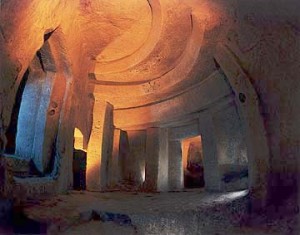The results of recent research suggests that ancient, or prehistoric, builders of the monumental structures found in such diverse places as Ireland, Malta, southern Turkey and Peru all have a peculiarly common characteristic — they may have been specially designed to conduct and manipulate sound to produce certain sensory effects.
Beginning in 2008, a recent and ongoing study of the massive 6,000-year-old stone structure complex known as the Hal Saflieni Hypogeum on the island of Malta, for example, is producing some revelatory results. Like its related prehistoric temple structures on Malta, this structure features central corridors and curved chambers. But this structure is unique in that it is subterranean, created through the removal of an estimated 2,000 tons of stone carved out with stone hammers and antler picks. Low voices within its walls create eerie, reverberating echoes, and a sound made or words spoken in certain places can be clearly heard throughout all of its three levels. Now, scientists are suggesting that certain sound vibration frequencies created when sound is emitted within its walls are actually altering human brain functions of those within earshot.
“Regional brain activity in a number of healthy volunteers was monitored by EEG through exposure to different sound vibration frequencies,” reports Malta temple expert Linda Eneix of the Old Temples Study Foundation, “The findings indicated that at 110 Hz the patterns of activity over the prefrontal cortex abruptly shifted, resulting in a relative deactivation of the language center and a temporary shifting from left to right-sided dominance related to emotional processing and creativity. This shifting did not occur at 90 Hz or 130 Hz……In addition to stimulating their more creative sides, it appears that an atmosphere of resonant sound in the frequency of 110 or 111 Hz would have been “switching on” an area of the brain that bio-behavioral scientists believe relates to mood, empathy and social behavior. Deliberately or not, the people who spent time in such an environment under conditions that may have included a low male voice — in ritual chanting or even simple communication — were exposing themselves to vibrations that may have actually impacted their thinking.” [1]
Researchers at the University of Malta are confirming the findings in an ongoing study.

Inside Malta’s Hal-Saflieni Hypogeum. Courtesy Old Temples Study Foundation
But the Hypogeum is not alone in its peculiar sound effects. A study conducted in 1994 by a consortium from Princeton University found that acoustic behavior in ancient chambers at megalithic sites such as Newgrange in Ireland and Wayland’s Smithy in England was characterized by a strong sustained resonance, or “standing wave” in a frequency range between 90 Hz and 120 Hz. “When this happens,” says Eneix, “what we hear becomes distorted, eerie. The exact pitch for this behavior varies with the dimensions of the room and the quality of the stone.” Going further back in time, she points to the ancient 10,000 B.C. site of Göbekli Tepe in southern Turkey. Built by hunter-gatherers, the site is thought by many scientists to be located in the area transitional to the first development of agriculture and domesticated livestock. Located on a hilltop, it consists of 20 round stone-built structures which had been buried. Those structures that have been excavated feature massive, T-shaped, standing limestone pillars. “In the center of a circular shrine,” she says, “a limestone pillar “sings” when smacked with the flat of the hand. Obviously made to represent a human with a decorated belt and hands carved in relief at its waist, it bears unexplained symbols in the area of the throat.” [1]

The site of Göbekli Tepe. Courtesy Old Temples Study Foundation
And now, new findings of a recent archaeoacoustic study suggests that the ancients of the 3,000-year-old Andean ceremonial center at Chavàn de Huà¡ntar, in the central highlands of Peru, practiced a fine art and science of manipulating sound with architecture to produce desired sensory effects. With the assistance of architectural form and placement, and sounds emitted from conch-shell trumpets, the “oracle” of Chavàn de Huà¡ntar “spoke” to the ancient center’s listeners.
Says Miriam Kolar, Stanford Interdisciplinary Graduate Fellow, PhD Candidate”¨ at Stanford University and leader of the study: ”¨”¨”At Chavàn, we have discovered acoustic evidence for selective sound transmission between the site’s Lanzon monolith and the Circular Plaza: an architectural acoustic filter system that favors sound frequencies of the Chavàn pututus [conch-shell trumpets] and human voice.” [2]
The Lanzon is a sacred statue or stela depicting the central deity of the ancient Chavàn culture. Thought to be Chavin’s central “oracle” for its inhabitants, it is housed in a chamber, part of a series of underground passages within the Old Temple of the ceremonial and religious center of Chavàn de Huà¡ntar. A central duct was built to connect the area of the Lanzon monolith with that of the Circular Plaza, an open-air place of ceremonial activity and significance. The duct was specifically designed to filter and magnify or conduct to a certain sound range — namely, the special range emitted by the Chavàn pututu instrument. The specific reasons for this acoustical configuration are not entirely understood, but studies involving human participants within the ancient architectural and artifact context of the site are indicating that the resultant sound effects may have been related to intentional auditory perceptual effects of sound and space on humans.
So what does all of this mean? What explains these similar, yet geographically and culturally disparate finds?
“How curious that such varied ancient structures, separated by so much time and distance, should have common features which imply sophisticated knowledge”, observes Eneix. “Did the architects of the day each make and develop their own discoveries or did they inherit a concept from some older school of learning? Adding the time element to other fields of comparison suggests human trail-blazing of monumental proportion.” [1]
A detailed article about the acoustical qualities of prehistoric ancient architecture is published in the March 2012 issue of Popular Archaeology Magazine, and a live illustrated presentation on the implications of acoustics in the creation of megalithic structures is in production. More information about the lecture, “Sound and the Onset of Building Monumentally” is available from The OTS Foundation.
More information about the temples of Malta and Gozo can be obtained by going to: www.otsf.org and www.ancientmed.org
Article Sources
http://popular-archaeology.com
[1] Linda Eneix, The Ancient Architects of Sound, Popular Archaeology Magazine, Vol. 6, March 2012. http://popular-archaeology.com
[2] Magic Sounds of Peru’s Ancient Chavàn de Huà¡ntar, Popular Archaeology Magazine, Vol. 5, December 2011. http://popular-archaeology.com

If you've ever found value in our articles, we'd greatly appreciate your support by purchasing Mindful Meditation Techniques for Kids - A Practical Guide for Adults to Empower Kids with the Gift of Inner Peace and Resilience for Life.
In the spirit of mindfulness, we encourage you to choose the paperback version. Delve into its pages away from screen glare and notifications, allowing yourself to fully immerse in the transformative practices within. The physical book enriches the learning process and serves as a tangible commitment to mindfulness, easily shared among family and friends.
Over the past few years, Wake Up World has faced significant online censorship, impacting our financial ability to stay online. Instead of soliciting donations, we're exploring win-win solutions with our readers to remain financially viable. Moving into book publishing, we hope to secure ongoing funds to continue our mission. With over 8,500 articles published in the past 13 years, we are committed to keeping our content free and accessible to everyone, without resorting to a paywall.







